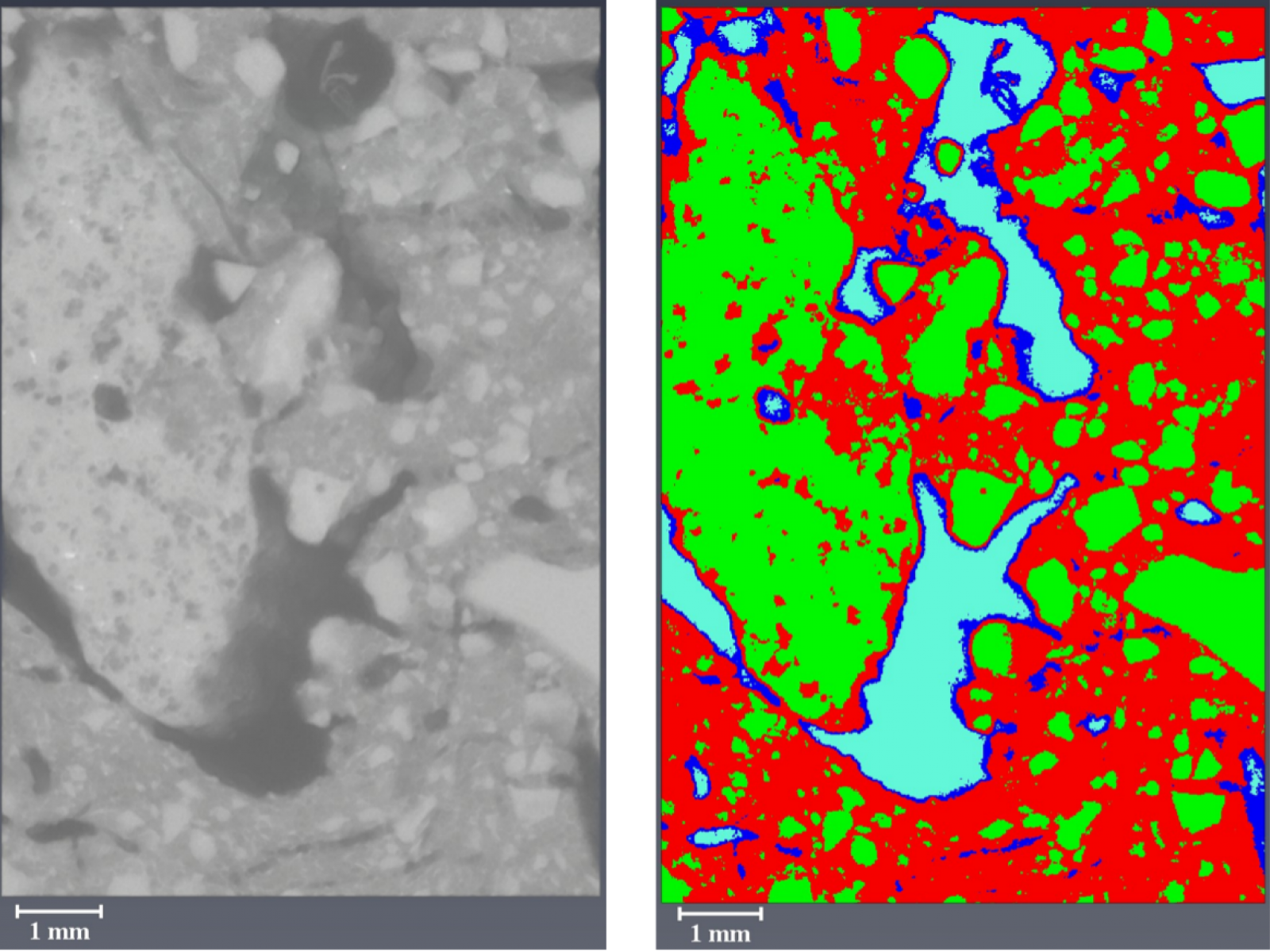Freeze-Thaw Cycles Alter Soil Structure in Thawing Permafrost
Soil pores are reorganized when newly thawed permafrost soils experience freeze-thaw cycling

Soil aggregates contain pore networks filled with water and air that can be impacted by continuous freezing and thawing. These impacts may play an important role in the function of previously frozen permafrost soil that is now becoming vulnerable to freeze-thaw processes. Using X-ray computed tomography, high density soil (green), low density soil (red), water (dark blue), and air (light blue) was differentiated, including how each fraction changed after freeze-thaw.
(Image courtesy of Rooney et al., 2022)
The Science
Climate change is increasing Arctic air temperatures, causing permafrost soils to thaw and then subjecting them to new and repeating cycles of freeze-thaw. Freeze-thaw cycles change the organization of pore spaces within soils, deforming single pores and the connections between pores (pore throats). This has consequences for the movement of water and solutes through the soil pore network. A new experiment examined the impact of freeze-thaw cycles on the pores of permafrost soil aggregates. Pore throat sizes and pore connectivity within the aggregate changed following five simulated freeze-thaw cycles, notably shifts in pore throat sizes under 100 microns and decreases in pore connectivity. The pore response to freeze-thaw varied across aggregates, indicating the importance of initial pore structures prior to freeze-thaw; the subsequent changes to pore size and connectivity has implications for water holding capacity and microbial access to carbon.
The Impact
The effect of freeze-thaw cycles on the physical structure of thawing permafrost soils can influence soil moisture and pore connectivity. The researchers observed a decrease in the relative volume of connected water-filled pores following freeze-thaw cycles, as well as an overall decrease in pore connectivity. Specifically, the frequency of pores connected only to one other pore (instead of multiple pores) increased following freeze-thaw. From this, they inferred that following a thaw, the initial freeze-thaw cycles will decrease the connectivity of permafrost soils. The finding has implications for water movement, gas flow, and microbial access to carbon in soils. It also highlights how permafrost thaw can result in transformations at the micro-scale, as well as larger landscape changes.
Summary
Climate change in Arctic landscapes may increase freeze-thaw frequency within the active layer (soil depths above the permafrost table that undergo seasonal thaw) as well as newly thawed permafrost. Freeze-thaw can deform soil pores and alter the architecture of the soil pore network with varied impacts to water transport and retention, redox conditions, and microbial activity. Researchers measured the impact of freeze-thaw cycles on pore morphology, pore throat diameter, and pore connectivity with X-ray computed tomography using six permafrost aggregates with sizes of 2.5 cm3 from a mineral soil horizon (Toolik, Alaska). Freeze-thaw cycles were performed using a laboratory incubation during which five freeze-thaw cycles (− 10 ˚C to 20 ˚C) were conducted. Spatial connectivity of the pore network decreased across all aggregates. Water-filled pores that were connected to the pore network decreased in volume while the overall connected pore volumetric fraction was not affected. Shifts in the pore throat diameter distribution were mostly observed in pore throats ranges of 100 µm or less with no corresponding changes to the pore shape factor of pore throats. Responses of the pore network to freeze-thaw varied by aggregate, suggesting that initial pore morphology may play a role in driving freeze-thaw response. This research suggests that freeze-thaw cycles alter the microenvironment of permafrost aggregates during the beginning stages of deformation following permafrost thaw, impacting soil properties and function in Arctic landscapes undergoing transition.
Funding
This research was supported by the Department of Energy, Office of Science, Biological and Environmental Research program as part of the Environmental System Science program. The Pacific Northwest National Laboratory is operated for DOE by Battelle Memorial Institute under contract DE-AC05-76RL01830. A portion of this research was performed on a project award no. 50267 from the Environmental Molecular Sciences Laboratory (grid.436923.9), a DOE Office of Science user facility at PNNL NEON is sponsored by the National Science Foundation and operated under cooperative agreement by Battelle. This material is based in part upon work supported by NSF through the NEON program.
Published: March 23, 2022
Rooney E.C., V.L. Bailey, K.F. Patel, M.I. Dragila, M.I. Dragila, A. Battu, and A.C. Buchko, et al. 2022. "Soil pore network response to freeze-thaw cycles in permafrost aggregates." Geoderma 411. doi:10.1016/j.geoderma.2021.115674